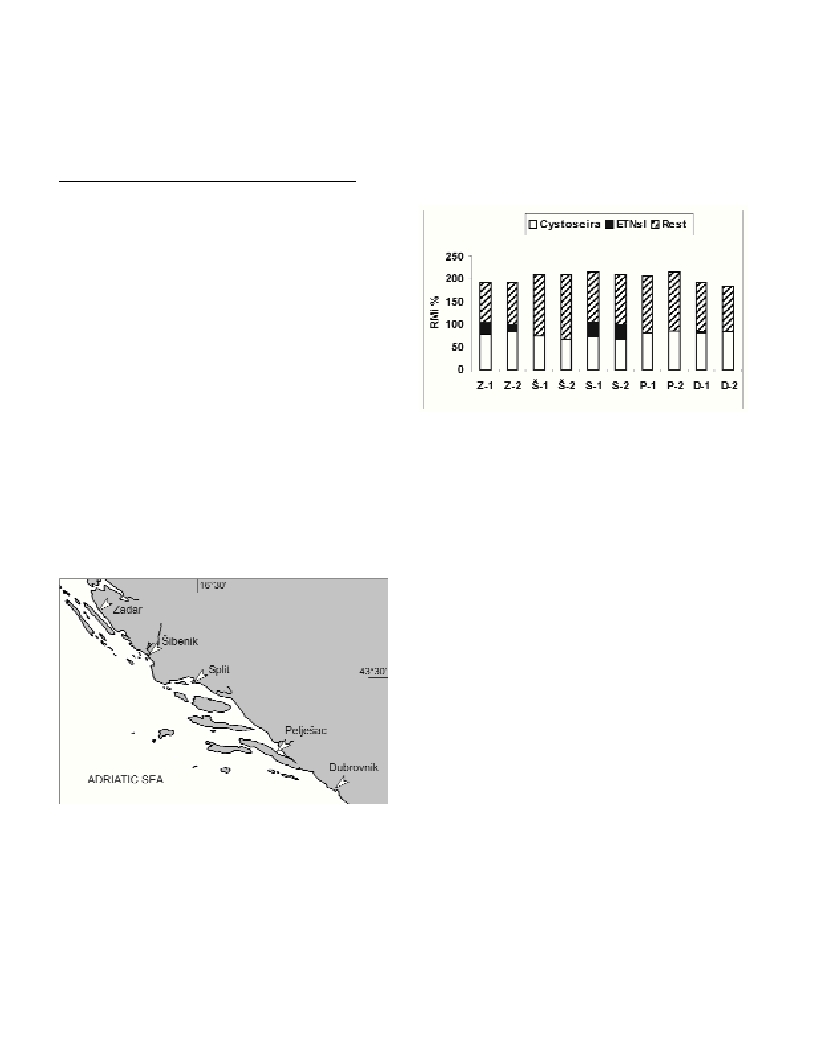SITUATION IN SHALLOW-WATER CYSTOSEIRASETTLEMENTS ON THE EASTERN ADRIATIC COAST
Boris Antolic *, Ante uljevic, Ivana Grubelic, Marija Despalatovic
Institute of Oceanography and Fisheries, Split, Croatia - * antolic@izor.hr
Abstract
In this paper is given the review of conditions of shallow-water Cystoseira settlements at 5 stations under different in?uence of pollutions
along the eastern Adriatic coast.
Keywords: pollution, Cystoseira settlements, Adriatic coast
Rapp. Comm. int. Mer Médit., 37,2004
475
Introduction
The Cystoseirasettlements are the climax vegetation on the hard
bottom in the Mediterranean Sea. Together with Posidonia oceanica
meadows, they are the main carrier of biodiversity in the infralittoral
zone. Since these settlements are bestdeveloped between the surface
and 10m depth, they are often exposed to marine pollution. In this
paper, the analysis of in?uence of pollution on the epilithic part of
shallow-water Cystoseira setllements on eastern Adriatic coast are
given.
Material and methods
The investigations were performed between 1995 and 1999 on 5
areas of the eastern Adriatic coast (Zadra, ibenik, Split, Peljeac
peninsula, Dubrovnik)(Fig. 1). The samples were collected by
SCUBA diving on 400 cm
2
squares from surface to 2m depth. The
epilithic algal taxa with a presence higher than 1% were considered.
The investigations covered the settlements ofCystoseira adriatica
Sauvageau, Cystoseira barbata (Stackhouse) C.Agardh,
C.compressa (Esper) Gerloff et Nizamudin, C. crinitophylla
Ercegovic, C. humilisKützingand C. spicata Ercegovicsubsp. crassa
Ercegovic,which are the leading components of the benthic algal
vegetation on the hard bottom of the eastern Adriatic coast (1). Special
attention was paid to algal taxa from ecological supergroup ETNsl
(including the eutrophic and tionitrophilic algae in a large sense) (2).
The structure of Cystoseirasetllements was studied by some phyto-
sociological parameters: mean total cover of the whole sample (Rt%),
mean total cover of the individual epilithic algal taxa (RMi%),
qualitative (DN%) and quantitative (DR%) dominance of ecological
supergroups (Phsl, Ssl, RMsl, ETNsl) and groups (ISR, D) (3).
Results and discussion
The total number of epilithic algal taxa varied between 44
(C.adriatica; ibenik) and 67 (C. barbata; Zadar), while the mean
total cover of sample (Rt%) varied from 183.91% (C. spicatasubsp.
crassa; Dubrovnik) to 217.90% (C. crinitophylla; Split). Mean total
covering of investigated Cystoseira(RMi%) varied between 66.60%
(C. crinitophylla; Split) and 85.00% (C. barbata; Peljeac). The
quantitative dominance (DR%) varied between 30.6%
(C.crinitophylla; Split) and 45.0% (C. spicatasubsp. crassa;
Dubrovnik) (Figure 2). The algal taxa of Ssl ecological supergroup
showed qualitative dominance (DN%) in the structure of the
Cystoseirasettlement. They were followed by the taxa of the Phsl
ecological supergroup, with some lower values of DN%. In the Ssl
ecological supergroup, the DN% values varied between 37.0%
(C.compressa; Split) and 50.0% (C. crinitophylla; Peljeac), and in
the Phsl ecological supergroup the values veried from 32.8% (C.
humillis; Dubrovnik) to 45.5% (C. adriatica; ibenik). The algal taxa
of the Phsl ecological supergroup predominated by quantitative
dominance (DR%). These values varied from 62.2% (C. compressa;
Zadar) to 71.6% (C. spicatasubsp. crassa).
The analysis of Cystoseira settlementsregarding the N, DN%, Rt%,
DR% and RMi% of individual algal taxa of ETNsl showed relatively
large ?uctuations. The highest values (8 and 9) were recorded in the
Zadar and Split areas, much lower in the Peljeac and Dubrovnik
areas (1, 2 or 3). In the ˇibenik area these algal taxa were not observed.
In areas with the best representation of this ecological supergroup
(Zadar, Split),the DN% values varied between 11.3% (C. compressa;
Zadar) and 13.0% (C. compressa; Split), than the DR% values varied
from 8.8% (C. barbata; Zadar) to 15.1% (C. compressa; Split). The
algal taxa that mostly contributed to the ETNsl quantitative
dominance by their individual mean total covering (RMi%) in Zadar
area in C.compressasettlement were: Ulva rigida(12.50%),
Chondracanthus acicularis(6,47%), Dictyopteris polypodioides
(3.38%) and Dictyota dichotoma var.intricata (2.21%); whereas, in
C.barbatasettlement were: U. rigida(7.08%), Ch. acicularis
(4.00%), D. polypodioides(3.67%) and D. dichotoma var intricata
(1.33%). Within the Split area, the C. compressa settlementconsisted
ofU. rigida(14.33%), Ch. acicularis(8.67%), D.polypodioides
(5.33%), Hypnea musciformis (1.67%) and Gastroclonium re?exum
(1.33%), whereas in the C. crinitophyllasettlement Ch. acicularis
(13.60%), U. rigida(9.70%), D.polypodioides(2.60%),
H.musciformis(2.20%), G. re?exum(1.60%) and D. dichotoma var.
intricata(1.20%) were present.
References
1-Ercegovic,A. 1952. Jadranske cistozire. Njihova morfologija,
ekologija i razvitak. - Sur les cystoseira adriatiques. Leur morphologie,
écologie et évolution. Fauna et Flora Adriatica, IOR, Split, 2: 1-212.
2-Boudouresque, F.C. 1984. Groupes ecologiques dalgues marines et
phytocenoses benthiques en Méditerranée nord-occidentale: une revue.
Giorn. Bot. Ital., 118 (Suppl. 2): 7-42.
3-Boudouresque, C.F. 1971. Méthodes détude qualitative et quantitative
du benthos (en particulier du phytobenthos). Téthys, 3(1): 79-104.
Fig. 1. Investigated area.
Fig. 2. Structure of epilithic part of Cystoseira settlements on the eastern
Adriatic coast.
(Z-1, Zadar-C.compressa; Z-2, Zadar-C.barbata; -1, ibenik-C.crnitophylla,
-2, ibenik-C.adriatica;
S-1, Split-C.compressa; S-2, Split-C.crinitophylla; P-1, Ploce-C.crinitophyl-
la; P-2, Ploce-C.barbata; D-1, Dubrovnik-C.humillis; D-2, Dubrovnik-C.spi-
cata.subsp.crassa)

